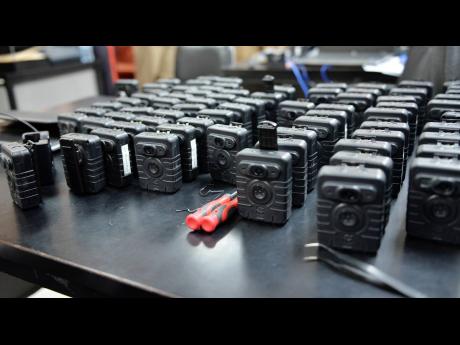BODY camera FOR SOLDIERS
The Jamaica Defence Force (JDF) has signalled that it is taking steps this year to have members of the army who work alongside the police during operations to be outfitted with body-worn cameras. This comes against the backdrop of the acquisition...
The Jamaica Defence Force (JDF) has signalled that it is taking steps this year to have members of the army who work alongside the police during operations to be outfitted with body-worn cameras. This comes against the backdrop of the acquisition of about 400 cameras by the police to be worn by officers during operations.
National Security Minister Dr Horace Chang said the Government would be acquiring another 1,000 body-worn cameras during the current financial year. He made those remarks during his contribution to the Sectoral Debate late last month. The police force has already acquired 400 body-worn cameras
In a Gleaner interview yesterday, Commissioner of the Independent Commission of Investigations (INDECOM), Hugh Faulkner said the JDF has informed him that it was on board in relation to the use and deployment of body-worn cameras. He said, however, that the extent of the distribution of these devices to soldiers will be based on the army’s budget this year.
Faulkner, who held talks with the leadership of the JDF in February, told The Gleaner that the High Command of the military “is very much on board” and appreciates the utility of these body-worn cameras.
Attempts to get a comment from two JDF spokespersons were unsuccessful as their phone numbers rang without answer.
Faulkner said that INDECOM will be able to comment on whether officers in the police force were issued with, trained with the use of body-worn cameras and deployed these devices in future quarterly reports.
“Each time we will be enquiring with a view for us down the road to make those data available to what extent were body-worn cameras used for each incident.”
The INDECOM boss said that his agency has already seen matters where body-worn cameras have been used but not with the regularity that the oversight body would desire.
He noted that even as the procurement of additional body-worn cameras is in train, INDECOM expects that when these are deployed it will see greater evidence of the use of body-worn cameras.
“The interests of justice and investigative accuracy to both civilians and police will be well served in the use of body-worn cameras,” he said.
He cited instances where there may be a fatality and there are no eyewitnesses. Faulkner added that in such a case the only account will be that of the security forces. “So it would be very helpful where body-worn cameras are deployed, especially in planned operations.”
The INDECOM commissioner indicated that in cases where the police are enforcing the Road Traffic Act and are interacting with motorists, the use of body-worn cameras may be helpful. “From time to time you might have verbal exchange and sometimes these may be elevated into allegations of physical contact so the body-worn cameras would help to turn the spotlight on truth,” he said.
Quizzed about how the body-worn cameras would be used, Faulkner indicated that there are established protocols that guide the use of those devices and if an officer is served with a camera he or she would not be expected to turn it off in the midst of an altercation, verbal or otherwise.
However, the INDECOM commissioner was unable to say whether the police had set up a system to store video footage from body-worn cameras. He said that in carrying out its oversight role INDECOM would be requesting footage from the police in cases where an incident has occurred.
The INDECOM head also told The Gleaner that there was a provision in the Law Reform (Zones of Special Operations) (Special Security and Community Development Measures) Act, 2017, also called the ZOSO law, which requires the use of body-worn cameras in areas that are declared ZOSOs.
Section 19 (1) of the Law Reform (Zones of Special Operations) (Special Security and Community Development Measures) Act, 2017, states that a member of the Joint Force shall, as far as is possible having regard to available resources, use a body-worn camera when conducting operations within a zone.
Section 19 (2) further states that the chief of defence staff and the commissioner of police shall establish and review the protocols and procedures for the use of body-worn cameras in zones.
During a press conference in February, Faulkner told reporters that he was looking forward to the availability of video footage to assist in proving incidents involving the police or exonerating them.
He said at the time that from initial talks with the leadership of the Jamaica Constabulary Force, the commission was satisfied that it would receive the full cooperation of the police.

